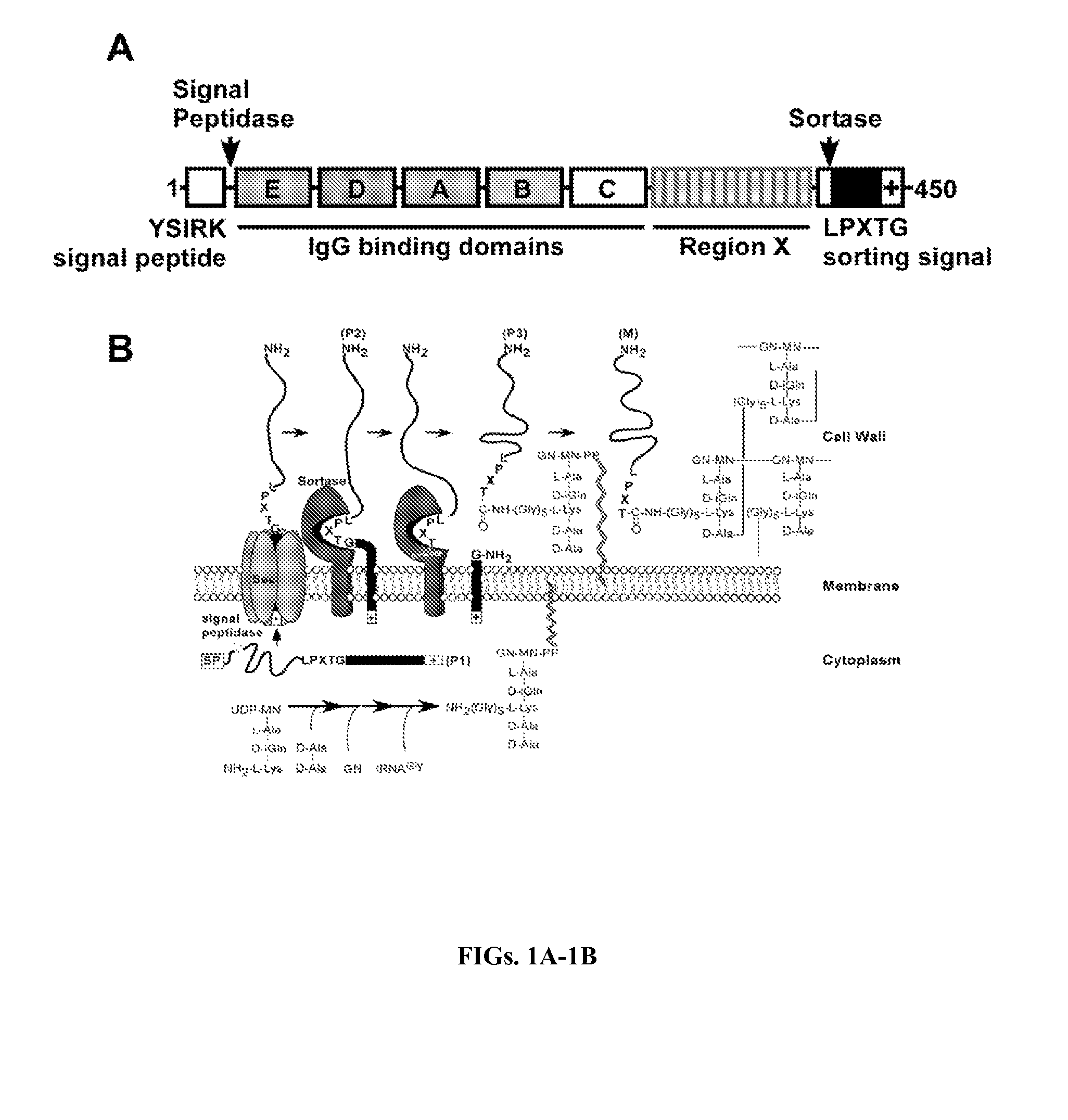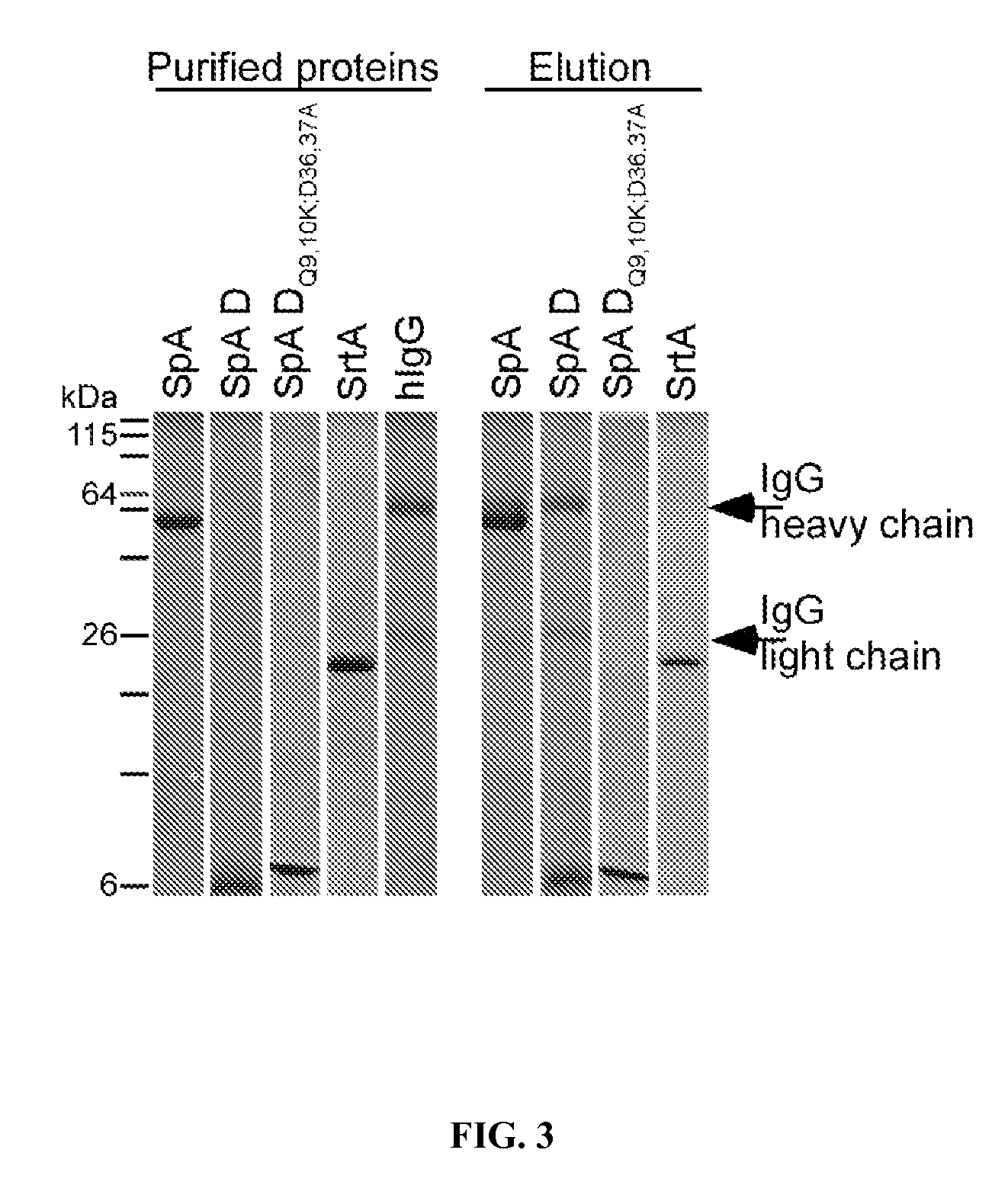Methods and compositions involving protective staphylococcal antigens
a staphylococcal antigen and composition technology, applied in the field of immunology, microbiology, pathology, can solve the problem that the possibility that this surface molecule may function as a vaccine in humans has not been rigorously pursued, and achieve the effect of reducing activity
- Summary
- Abstract
- Description
- Claims
- Application Information
AI Technical Summary
Benefits of technology
Problems solved by technology
Method used
Image
Examples
example 1
Non-Toxigenic Protein A Variants as Subunit Vaccines to Prevent Staphylococcus aureus Infections
[0331]A. Results
[0332]An Animal Model for S. aureus Infection
[0333]BALB / c mice were infected by intravenous injection with 1×107 CFU of the human clinical isolate S. aureus Newman (Baba et al., 2007). Within 6 hours following infection, 99.999% of staphylococci disappeared from the blood stream and were distributed via the vasculature. Staphylococcal dissemination to peripheral tissues occurred rapidly, as the bacterial load in kidney and other peripheral organ tissues reached 1×105 CFU g−1 within the first three hours. The staphylococcal load in kidney tissues increased by 1.5 log CFU within twenty-four hours. Forty-eight hours following infection, mice developed disseminated abscesses in multiple organs, detectable by light microscopy of hematoxylin-eosin stained, thin-sectioned kidney tissue. The initial abscess diameter was 524 μM (±65 μM); lesions were initially marked by an influx o...
example 2
Non-Toxigenic Protein A Vaccine for Methicillin-Resistant Staphylococcus aureus Infection
[0360]Clinical isolates of S. aureus express protein A (Shopsin et al., 1999, whose primary translational product is comprised of an N-terminal signal peptide (DeDent et al., 2008), five Ig-BDs (designated E, D, A, B and C) (Sjodahl, 1977), region X with variable repeats of an eight residue peptide (Guss et al., 1984), and C-terminal sorting signal for the cell wall anchoring of SpA (Schneewind et al., 1992; Schneewind et al., 1995) (FIG. 6). Guided by amino acid homology (Uhlen et al., 1984), the triple α-helical bundle structure of IgBDs (Deisenhofer et al., 1978; Deisenhofer et al., 1981) and their atomic interactions with Fab VH3 (Graille et al., 2000) or Fcγ (Gouda et al., 1998), glutamine 9 and 10 were selected as well as aspartate 36 and 37 as critical for the association of SpA with antibodies or B cell receptor, respectively. Substitutions Gln9Lys, Gln10Lys, Asp36Ala and Asp37Ala were i...
example 3
Active Immunization Using Subunit Vaccine Including Multiple Antigens
[0383]BALB / c mice (n=18-20) were either mock immunized with PBS / adjuvant or injected with 25 μg of each antigen (Combo 1, ClfA+SdrD+FnBPB; Combo 2, Combo 1+SpAKKAA). Immunized mice were challenged by intravenous inoculation with 1×107 CFU S. aureus Newman. Bacterial loads in kidney tissues were examined at day 4 (FIG. 13A) and day 18 (FIG. 13B) post challenge. Statistical significance was calculated with the unpaired two-tailed Students t-test and P-values recorded; P-values <0.05 were deemed significant. Combo 1 and Combo 2 showed significant reduction in bacterial load at 4 and 18 days post challenge.
[0384]Genetic Vaccinology Identifies Protective Antigens of S. aureus. The putative protective antigens identified by genetic vaccinology are sortase A-anchored surface proteins with C-terminal LPXTG sorting signals. Previous work assessed the contribution of surface proteins to disease pathogenesis and vaccine prote...
PUM
| Property | Measurement | Unit |
|---|---|---|
| temperatures | aaaaa | aaaaa |
| bed volume | aaaaa | aaaaa |
| total volume | aaaaa | aaaaa |
Abstract
Description
Claims
Application Information
 Login to View More
Login to View More - R&D
- Intellectual Property
- Life Sciences
- Materials
- Tech Scout
- Unparalleled Data Quality
- Higher Quality Content
- 60% Fewer Hallucinations
Browse by: Latest US Patents, China's latest patents, Technical Efficacy Thesaurus, Application Domain, Technology Topic, Popular Technical Reports.
© 2025 PatSnap. All rights reserved.Legal|Privacy policy|Modern Slavery Act Transparency Statement|Sitemap|About US| Contact US: help@patsnap.com



